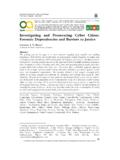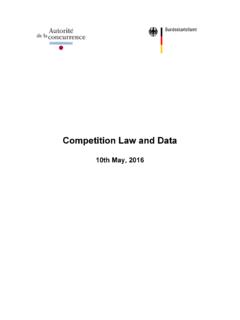Transcription of 195-31: Using SAS® to Investigate Effect …
1 1 Paper 195-31 Using SAS To Investigate Effect Modification Peter H. Van Ness, Heather G. Allore Program on Aging, Department of Internal Medicine, Yale University School of Medicine, New Haven, CT ABSTRACT Effect modification occurs in biomedical research when a measure of statistical association between an exposure and a health outcome, as represented on some specific scale, differs according to the levels of a third variable the Effect modifier. The heterogeneity of a measure of association across the levels of a modifying variable has an importance that might be statistical, epidemiologic, and/ or biologic.
2 Respectively, it might contribute to the goodness of fit of a regression model, identify subgroups for which a health risk factor is especially prominent, and/ or specify a multifactorial causal relationship. Effect modification can be tested and graphed in numerous ways with SAS statistical software. In this article we will provide code for six different ways of investigating Effect modification, primarily Using PROC GENMOD, and two ways of graphing statistical interactions Using the GPLOT and (via ActiveX Control) the G3D procedures.
3 Advantages and disadvantages of each approach will be stated. Statistical interaction should not be confused with biological interaction. Causal biologic relationships can only be analyzed meaningfully in longitudinal studies. This article will conclude with a discussion of the relationship between representing statistical interactions in SAS software and drawing causal statistical inferences in longitudinal studies. Specifically, the strengths and limitations of fitting marginal structural models for time-varying confounding with PROC GENMOD will be identified.
4 INTRODUCTION TO Effect MODIFICATION Upon regressing an outcome variable on an exposure variable, epidemiologists characteristically next Investigate potential confounding factors and Effect modifiers (Harrell 2001). Confounders variables associated with both the exposure and outcome that alter the association between them but are not in their causal pathways are not of substantive interest. Their inclusion in a regression model is intended to prevent bias in estimates of a hypothesized association. Contrarily, Effect modifiers are often of substantive importance.
5 In some circumstances interaction terms might be included in regression models solely to promote goodness-of-fit, , their interpretation as specification of subgroup associations or biologic interactions is implausible but their presence in the model promotes a distribution of residuals that better satisfies model assumptions. In most applications, however, statistically significant interactions between covariates and a main predictor are qualifications or extensions of hypothesized associations that merit careful representation in a report of a biomedical research study.
6 Hence, identifying different ways in which Effect modification can be investigated with SAS software, and specifically, with PROC GENMOD, is not only a matter of technical practice but also of inferential interpretation. Effect modification occurs when a measure of statistical association between an exposure and an outcome, as represented on some specific scale, differs according to the levels of a third variable the Effect modifier. The statistical significance of an interaction term crossing an exposure predictor with a potential modifier establishes the modification of the measure of association and provides evidence for a modification of a sociologic or biologic Effect .
7 (For simplicity we will speak henceforth of predictors and modifiers recognizing that the model might include more predictors than the one crossed with a modifier and that the modifier is only potential until shown to be statistically significant.) Clearly, presence of statistical interaction is not sufficient to establish the presence of causal biologic interaction. To emphasize this point Greenland and Rothman prefer the term Effect measure modification (Greenland and Rothman 1998). Last makes the same point differently by defining an Effect modifier as the modification of the Effect of a putative causal factor (emphasis added) (Last 2001).
8 Mindful of these important interpretive caveats, this article uses the variant of the term common in epidemiology and biostatistics (Miettinen 1974). Statistics and Data AnalysisSUGI31 2 Six Coding Approaches A strength of SAS statistical software is its flexibility and comprehensiveness. Accordingly, there are numerous ways that an analyst can Investigate suspected Effect modification. Six will be described here; code for each is provided in Appendix A. For clarity we will consider the case in which the outcome, predictor, and modifier variables are all binary.
9 The Analytic Approach: The simplest approach uses the FREQ procedure to generate two 2 x 2 tables, one for each level of the modifier (Appendix ). The extent to which the odds ratios for the two tables differ is the extent to which modification occurs. A Breslow-Day statistic generated by adding the chm option to the tables statement tests the homogeneity of the odds ratios across the levels of the modifier. The advantage of this approach is that it allows you to inspect the joint distributions of the two tables, identifying low cell counts or complete separations if they occur.
10 Also, with appropriate coding of the variables, it allows for easy calculation and comparison of odds ratios and risk ratios as measures of association. Its disadvantage is that it doesn t explicitly provide all potentially relevant information, , residuals and other diagnostic information, and even p-values for the odds ratios and risk ratios. Of course, this approach is not appropriate when the outcome or predictor is measured on a continuous or count scale or when there are many additional covariates. The Stratified Regression Approach: A second approach is to perform stratified logistic regressions Using the by statement to generate separate analyses for each level of a modifier (Appendix ).

















